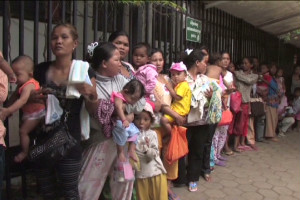
It’s back to basics: Just wash your hands thoroughly and frequently, and observe strict personal hygiene to prevent the spread of the so-called “mysterious disease” that has already claimed the lives of at least 50 children in Cambodia.
The Department of Health (DOH) on Monday dispensed these tips to the public after the World Health Organization (WHO) linked the mysterious disease in Cambodia to Enterovirus 71 (EV-71), which causes a deadlier hand, foot and mouth disease (HFMD).
But Health Secretary Enrique Ona said HFMD should not be confused with the foot and mouth disease in animals.
Based on its investigation conducted with the Cambodian Ministry of Health, the WHO said a significant portion of the samples tested positive for EV-71, known to “generally cause severe complications among some patients.”
But laboratory samples were not available for the majority of the cases as the patients, aged between 3 months to 11 years old, died before appropriate samples could be taken, the health agency said. As of July 5, 59 children had been affected by the syndrome, 52 of them fatally.
Body secretions
 A further investigation of the available samples also showed traces of other pathogens, including dengue and Streptococcus suis, a pathogen of pigs capable of being transmitted to humans.
A further investigation of the available samples also showed traces of other pathogens, including dengue and Streptococcus suis, a pathogen of pigs capable of being transmitted to humans.
In a statement, Ona described HFMD as an illness affecting mostly children which is commonly spread after direct contact with body secretions coming from infected people, like saliva. Adults, however, appear to be protected against the disease “possibly because of early infection in childhood,” the DOH secretary said.
“Hand washing and strict personal hygiene limit its spread,” Ona said. “As the cause of HFMD is viral, antibiotics will not be of any help in treating it.”
The WHO also advised patients infected with the disease to drink plenty of fluids to reduce the chance of dehydration due to high fever and to avoid taking steroids. Parents should seek medical help if their children suddenly develop high fever, vomit and show signs of lethargy and limb weakness, the WHO added.
Ona on Monday instructed the Bureau of Quarantine to boost the screening process of all arriving international travelers as a routine precaution against the disease. But there were no travel restrictions yet to and from Cambodia, he added.
He also directed hospitals to be on the lookout for similar cases as a means of enhancing surveillance.
The quarantine office at Ninoy Aquino International Airport (Naia) is now “closely monitoring” incoming passengers at Naia Terminals 1, 2, 3 and 4, according to the Manila International Airport Authority’s (MIAA) public affairs office.
While the MIAA has yet to come up with specific guidelines regarding the mysterious disease, the quarantine office is “currently using thermal scanners in all terminals to determine who among the passengers have a high temperature and signs of physical discomfort.”
An average of 12,000 incoming passengers a day use the four Naia terminals.
 Negative for H5N1
Negative for H5N1
The samples tested negative for H5N1 and other influenza viruses, SARS (Severe Acute Respiratory Syndrome) and the Nipah virus, which causes severe illness characterized by the inflammation of the brain or respiratory diseases, noted the WHO.
EV-71 is known to cause HFMD, which according to health experts, is a common disease among infants and children which has been associated with more serious complications and may cause death.
Symptoms include fever that may last 24 to 48 hours, painful sores in the mouth and a rash and blisters on the hands, feet and buttocks.
The first outbreak related to EV-71 was recorded in California in 1969. It extended to Europe with outbreaks in Bulgaria and Hungary between 1975 and 1978 before it spread to various countries in Asia.-Philippine Daily Inquirer (July 10, 2012)

No comments:
Post a Comment